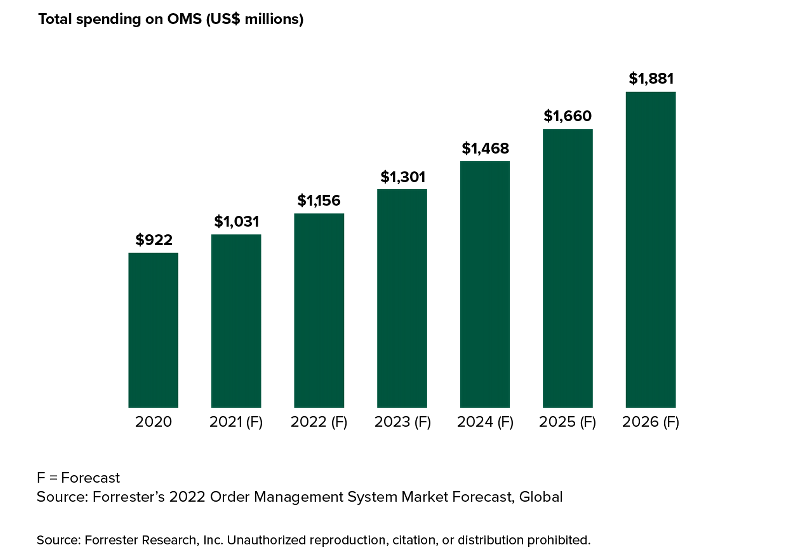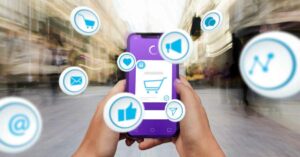The enormous volume of orders and shipments that eCommerce generates can usher in a host of challenges. These could include challenges of meeting stiff delivery targets, inventory management issues, warehousing problems, supply chain constraints, maintaining order accuracy, efficiently processing returns, etc.
It’s here that effective order management becomes critical. A good Order Management System (OMS) helps companies track and manage their orders more effectively. They can keep track of their inventory, part numbers, vendors, sales channels, customer information, and more. In the past few years, there has been a new wave of demand for OMS. Forrester expects the global spending on OMS software to reach $1.9 billion by 2026.

For the purpose of this blog, we will explore some of the most popular trends, evolving solutions, and challenges associated with order management.
Top Trends in Order Management
Here are some of the top trends reshaping order management:
Speedy Distribution and Order Fulfillment
One of the most noticeable trends is the need for lightning-fast distribution and order fulfillment. Customers expect their orders to arrive on their doorstep not too long after they click the “Buy Now” button. This trend is driven by the rise of same-day and next-day delivery services spurred by giants like Amazon. To keep pace, businesses are investing in automated warehouses, optimizing supply chains, and offering efficient last-mile delivery solutions.
Multichannel Customer Support
The multichannel order management market reached $2.7 billion in 2022 and is projected to be worth $4.2 billion by 2027, growing at a CAGR of 9.4%.
Indeed, customer support is no longer confined to a single channel. With the advent of social media, chatbots, email, and more, customers now seek assistance across various platforms. This trend has led to the integration of multichannel customer support within order management systems.
Multichannel OMS add-ons that are available in today’s market include web services, mobile apps, enterprise resource planning modules, and more. These features improve customer interaction by connecting eCommerce channels with call center operations and service desk support.
Real-Time Data Collection
Data is the lifeblood of modern eCommerce. To gain a competitive edge, businesses are harnessing the power of real-time data collection. With IoT devices, RFID technology, and advanced analytics, companies can monitor their entire supply chain in real-time. This not only improves order accuracy but also enables proactive issue resolution.
By leveraging predictive analytics, in particular, companies can foresee potential disruptions, such as weather-related delays, and take preemptive actions to mitigate their impact on order fulfillment.
Changes in Post-Purchase Expectations
The customer journey doesn’t end when a purchase is made. Post-purchase expectations have evolved significantly. Customers now demand order tracking, easy returns, and transparent communication throughout the delivery process. This trend has prompted businesses to invest in customer-centric post-purchase solutions.
Automated order tracking, self-service return portals, and real-time updates via SMS or email are just some of the ways companies are meeting these expectations.
Integrating with New Marketplaces
Expanding to new marketplaces is another notable trend. As eCommerce continues to thrive, businesses are looking beyond their websites to reach a broader audience. Marketplaces like eBay, Walmart Marketplace, and Shopify Plus are gaining traction.
To manage orders effectively across these platforms, companies are turning to order management solutions that offer seamless integration, centralized order processing, and inventory synchronization.
Evolving Order Management Solutions
The future of order management is all about flexibility, transparency, and agility. Businesses need to be able to adapt to changing market conditions and customer demands quickly and efficiently. Order management solutions are evolving to meet these needs, with a focus on:
Flexibility in Deployment Choices
Order management solutions are now available in a variety of deployment options, including cloud, on-premises, and hybrid. This gives businesses the flexibility to choose the deployment option that best meets their specific needs and budget.
Order Aggregation
Order aggregation platforms allow businesses to combine orders from multiple channels into a single order. This can help them reduce shipping costs and improve efficiency.
Omnichannel Order Fulfillment
Omnichannel order fulfillment allows businesses to meet user expectations by fulfilling orders from a variety of channels, such as their website, brick-and-mortar stores, and other marketplaces.
Real-Time Inventory Visibility
Real-time inventory visibility is essential for ensuring that you can always meet customer expectations. Studies indicate that a mere 63% of companies maintain precise control over their inventory.
With real-time inventory visibility, businesses can track their inventory levels across all of their channels and warehouses. This can allow them to avoid overselling and backorders. The OMS software should help facilitate this.
Emerging Challenges in Order Management
Order management is not without its challenges, especially in the face of a rapidly evolving eCommerce ecosystem.
Scalability Challenges
eCommerce’s rapid growth means handling larger order volumes efficiently. That requires the firm to be able to maintain speed, accuracy, and customer satisfaction. However, legacy order management deployments may struggle with this.
Data Security and Compliance
Data safety and compliance are paramount, with regulations like GDPR, CCPA, and PCI DSS governing data sharing and access. Besides, consumers also worry about their data being exploited. As such, the order management systems need robust security features and compliance tools.
Returns and Refunds Management
Higher sales also mean increased returns. Managing returns efficiently is critical to sustaining customer satisfaction and keeping operational costs in check. However, that requires eCommerce firms to be able to employ automated return processes, from initiation to restocking.
Technology is the backbone here. In fact, 91% of Fortune 50 retailers and 63% of D2C brands were already employing solutions like a robust online portal or an app in 2021 to facilitate the returns process. However, eCommerce firms often don’t have the in-house expertise to manage such a sophisticated tech stack and update it constantly.
Elevated Customer Expectations
Of course, we now know that customers expect fast, convenient, transparent, and flexible ordering experiences. Meeting these demands necessitates real-time order tracking, seamless communication, and customization options. All in all, eCommerce firms need to enhance the entire customer journey.
Enabling Effective Order Management with Magento
Magento, known for its flexibility, scalability, and security, is one of the most popular eCommerce platforms in the world, and it is an excellent option for eCommerce businesses of all sizes.
The Magento Order Management System brings forth a host of capabilities, from distributed order management to business intelligence, holistic inventory management, mobile POS, etc.
At Ignitiv, we customize Magento deployments for your specific order management needs.
As a Magento development services company, we can help you:
- Implement, customize, and manage Magento OMS.
- Integrate Magento OMS with other business-critical systems, such as ERP, CRM, payment gateways, shipping providers, and more.
- Automate and simplify the order fulfillment processes for handling a substantial amount of orders, especially during peak seasons.
- Facilitate omnichannel order management.
Book a call with us today to learn more about how we can help create a robust, customized order management solution for your eCommerce business.








